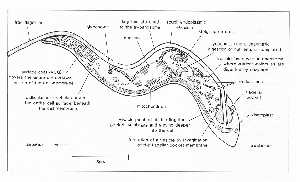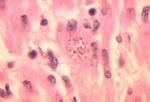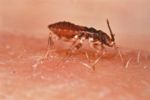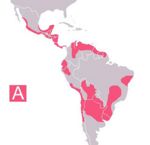Difference between revisions of "Trypanosoma"
| (33 intermediate revisions by 6 users not shown) | |||
| Line 1: | Line 1: | ||
| − | [[Image:Trypanosoma.jpg|thumb|right|150px|''Trypanosoma cruzi'' | + | {{OpenPagesTop}} |
| − | [[Image:T.cruzi in monkey heart.jpg|thumb|right|150px|''T. cruzi'' in monkey heart | + | {{Taxobox |
| − | + | |name = ''Trypanosoma sp'' | |
| + | |kingdom = Protista | ||
| + | |sub-kingdom = | ||
| + | |phylum = [[Protozoa]] | ||
| + | |super-class = | ||
| + | |class = | ||
| + | |sub-class = | ||
| + | |super-order = | ||
| + | |order = Kinetoplastida | ||
| + | |sub-order = | ||
| + | |super-family = | ||
| + | |family = Trypanosomatidae | ||
| + | |sub-family = | ||
| + | |genus = Trypanosoma | ||
| + | |species = | ||
| + | }} | ||
| + | [[File:Trypanosoma brucei.gif|thumb|300px|right|Schematic diagram of ''Trypanosoma brucei'']] | ||
| + | [[Image:Trypanosoma.jpg|thumb|right|150px|''Trypanosoma cruzi'' <br> CDC/Dr. Myron G. Schultz, WikiMedia Commons]] | ||
| + | [[Image:T.cruzi in monkey heart.jpg|thumb|right|150px|''T. cruzi'' in monkey heart <br> Dr. L.L. Moore Jr., WikiMedia Commons]] | ||
[[Image:Triatoma infestans.jpg|thumb|right|150px|''Triatoma infestans'' the Kissing bug - WHO Wikimedia Commons]] | [[Image:Triatoma infestans.jpg|thumb|right|150px|''Triatoma infestans'' the Kissing bug - WHO Wikimedia Commons]] | ||
[[Image:Chagas endemic zones 2005.jpg|thumb|right|150px|Chagas endemic zones 2005 - Wikimedia Commons]] | [[Image:Chagas endemic zones 2005.jpg|thumb|right|150px|Chagas endemic zones 2005 - Wikimedia Commons]] | ||
| − | [[ | + | ==Introduction== |
| − | + | Trypanosomes are '''elongated unicellular [[Protozoa |protozoal]]''' organisms with an undulating membrane and anterior flagellum. | |
| − | + | ==Lifecycle== | |
| + | The trypanosomes are transmitted by '''haematophagous insect''' vectors including the '''[[Glossinidae |tsetse fly]]''' and '''triatomid''' kissing bug. | ||
| − | + | ===Stercorarian=== | |
| + | Stercorarian trypanosomes develop in the '''posterior gut''' of the insect and infective '''metatrypanosomes''' are excreted in the '''faeces''' of the insect onto the '''skin''' of the host. | ||
| − | + | They can then '''penetrate''' the tissues, gaining access through skin abrasions or mucous membranes. The metatrypanosomes then multiply within the reticulo-endothelial system of the host, later '''disseminating''' throughout the organs invading host cells residing within parasitophorous vacuole. These vacuoles acidify and subsequently release '''trypomastigotes''' into the cell cytoplasm. These then develop into '''amastigotes''' which divide several times eventually transforming back into trypomastigotes that rupture the host cell. From here they may invade other cells or enter the bloodstream where the opportunity may arise to infect the insect vector. The amastigotes may also burst the host cell and invade other cells. | |
| − | |||
| − | |||
| − | + | '''''T. cruzi''''', the trypanosome of '''most human importance''', is a typical Stercorarian trypanosome and utilises the '''triatomid “kissing bug”''' as its vector among others. Disease in dogs may also occur. | |
| − | |||
| − | |||
| − | |||
| − | |||
| − | |||
| − | |||
| − | |||
| − | |||
| − | |||
| − | |||
| − | + | ''T. theileri'' infects cattle and is transmitted by [[Tabanidae |tabanid flies]], [[Stomoxys calcitrans |stable flies]], [[Ticks |ticks]] and [[Culicidae |mosquitoes]]. | |
| − | |||
| − | + | ===Salivarian=== | |
| − | + | Salivarian trypanosomes develop in the '''anterior gut''' of their vector, the '''[[Glossinidae |Tsetse fly]]'''. | |
| − | |||
| − | |||
| − | ''' | + | Development occurs in the '''proboscis''' and midgut, forming '''epimastigotes''' which then invade the '''hypopharynx''' and develop into '''trypomastigotes''' and then '''infective metatrypanosomes''' form. |
| − | |||
| − | + | These are then innoculated into the mammalian host through a '''bite''' before a blood meal. | |
| − | + | ==Pathogenesis== | |
| − | + | Trypanosomes '''deplete''' carbohydrates, proteins, lipids and micronutrients from their hosts. | |
| − | + | They cause '''haemolytic [[Anaemia |anaemia]]''' when present within the bloodstream. | |
| − | + | ==Diseases== | |
| − | + | [[Trypanosomosis]] affects the lymphoid and haematopoeitic systems of a wide range of hosts. | |
| − | + | ===Salivarian Species=== | |
| − | + | ''T. brucei'' affects '''all domestic mammals''', including small and farm species, and humans. It also causes a specific [[Protozoal Skin Infections - Donkey|skin disease in donkeys]]. | |
| − | + | ''T. vivax'' infects ruminants, horses and camels causing significant disease. | |
| − | |||
| − | |||
| − | + | ''T. equiperdum'' causes '''venereal''' equine disease '''dourine'''. It is the only trypanosome that does not immediately require an insect vector for transmission, being spread through coitus. | |
| − | |||
| − | |||
| − | ''' | + | ''T. simiae'' causes fatal pyrexia in '''pigs''' while ''T. congolense'' is milder in the same species. |
| − | + | ||
| − | + | ''T. congolense'' can also affect '''dogs and cats''' causing acute fever, anaemia and neurological signs. | |
| − | |||
| − | + | ''T. evansi'' also affects all domestic mammals. | |
| − | |||
| − | |||
| − | |||
| − | |||
| − | |||
| − | |||
| − | |||
| − | |||
| − | + | ===Stercorarian Species=== | |
| − | + | '''''T. cruzi''''' occurs in '''South America''' where it is transmitted by a triatomid (kissing) bug and infects armadillos, possums and humans. It is known as '''''Chagas’ Disease'''''. | |
| − | + | A similar acute disease is thought to be caused by ''T. cruzi'' in dogs in the USA. | |
| − | |||
| − | |||
| − | + | ''T. melophagum'' and ''T. theileri'' are '''non-pathogenic''' species present in the '''UK''' infecting cattle, buffalo and antelope. Stress and concurrent disease are thought to be contributors to the development of clinical disease from ''T. theileri''. | |
| − | |||
| − | |||
| − | |||
| − | |||
| − | + | {{Learning | |
| − | + | |flashcards = [[Trypanosoma Flashcards]] | |
| − | + | [[Protozoa_Flashcards#Tropical_Protozoa|Tropical Protozoa Flashcards]] | |
| − | + | |Vetstream = [https://www.vetstream.com/canis/search?s=protozoa Protozoa] | |
| − | + | }} | |
| − | |||
| − | |||
| − | |||
| − | + | ==References== | |
| − | + | <references/> | |
| − | + | {{CABI source | |
| + | |datasheet = [http://www.cabi.org/ahpc/?compid=3&dsid=96918&loadmodule=datasheet&page=2144&site=160 ''Trypanosoma''] | ||
| + | |date = 6 June 2011 | ||
| + | }} | ||
| + | <br><br><br> | ||
| − | + | {{Nick Lyons | |
| − | + | |date = October 29, 2011}} | |
| − | |||
| − | + | {{OpenPages}} | |
| − | |||
| − | |||
| − | |||
| − | |||
| − | |||
| − | |||
| − | |||
| − | |||
| − | |||
| − | |||
| − | |||
| − | |||
| − | |||
| − | |||
| − | |||
| − | |||
| − | |||
| − | |||
| − | |||
| − | |||
| − | |||
| − | |||
| − | |||
| − | |||
| − | |||
| − | |||
| − | |||
| − | |||
| − | |||
| − | |||
| − | |||
| − | |||
| − | |||
| − | |||
| − | |||
| − | |||
| − | |||
| − | |||
| − | |||
| − | |||
| − | |||
| − | |||
| − | |||
| − | |||
| − | |||
| − | |||
| − | |||
| − | |||
| − | |||
| − | |||
| − | |||
| − | |||
| − | |||
| − | |||
| − | |||
| − | |||
| − | |||
| − | |||
| − | |||
| − | |||
| − | |||
| − | |||
| − | |||
| − | |||
| − | |||
| − | |||
| − | |||
[[Category:Tropical Protozoa]] | [[Category:Tropical Protozoa]] | ||
| + | [[Category:CABI Expert Review Completed]][[Category:CABI AHPC Pages]] | ||
| + | [[Category:Nick Lyons reviewed]] | ||
Latest revision as of 17:59, 4 June 2016
| Trypanosoma sp | |
|---|---|
| Kingdom | Protista |
| Phylum | Protozoa |
| Order | Kinetoplastida |
| Family | Trypanosomatidae |
| Genus | Trypanosoma |
Introduction
Trypanosomes are elongated unicellular protozoal organisms with an undulating membrane and anterior flagellum.
Lifecycle
The trypanosomes are transmitted by haematophagous insect vectors including the tsetse fly and triatomid kissing bug.
Stercorarian
Stercorarian trypanosomes develop in the posterior gut of the insect and infective metatrypanosomes are excreted in the faeces of the insect onto the skin of the host.
They can then penetrate the tissues, gaining access through skin abrasions or mucous membranes. The metatrypanosomes then multiply within the reticulo-endothelial system of the host, later disseminating throughout the organs invading host cells residing within parasitophorous vacuole. These vacuoles acidify and subsequently release trypomastigotes into the cell cytoplasm. These then develop into amastigotes which divide several times eventually transforming back into trypomastigotes that rupture the host cell. From here they may invade other cells or enter the bloodstream where the opportunity may arise to infect the insect vector. The amastigotes may also burst the host cell and invade other cells.
T. cruzi, the trypanosome of most human importance, is a typical Stercorarian trypanosome and utilises the triatomid “kissing bug” as its vector among others. Disease in dogs may also occur.
T. theileri infects cattle and is transmitted by tabanid flies, stable flies, ticks and mosquitoes.
Salivarian
Salivarian trypanosomes develop in the anterior gut of their vector, the Tsetse fly.
Development occurs in the proboscis and midgut, forming epimastigotes which then invade the hypopharynx and develop into trypomastigotes and then infective metatrypanosomes form.
These are then innoculated into the mammalian host through a bite before a blood meal.
Pathogenesis
Trypanosomes deplete carbohydrates, proteins, lipids and micronutrients from their hosts.
They cause haemolytic anaemia when present within the bloodstream.
Diseases
Trypanosomosis affects the lymphoid and haematopoeitic systems of a wide range of hosts.
Salivarian Species
T. brucei affects all domestic mammals, including small and farm species, and humans. It also causes a specific skin disease in donkeys.
T. vivax infects ruminants, horses and camels causing significant disease.
T. equiperdum causes venereal equine disease dourine. It is the only trypanosome that does not immediately require an insect vector for transmission, being spread through coitus.
T. simiae causes fatal pyrexia in pigs while T. congolense is milder in the same species.
T. congolense can also affect dogs and cats causing acute fever, anaemia and neurological signs.
T. evansi also affects all domestic mammals.
Stercorarian Species
T. cruzi occurs in South America where it is transmitted by a triatomid (kissing) bug and infects armadillos, possums and humans. It is known as Chagas’ Disease. A similar acute disease is thought to be caused by T. cruzi in dogs in the USA.
T. melophagum and T. theileri are non-pathogenic species present in the UK infecting cattle, buffalo and antelope. Stress and concurrent disease are thought to be contributors to the development of clinical disease from T. theileri.
| Trypanosoma Learning Resources | |
|---|---|
To reach the Vetstream content, please select |
Canis, Felis, Lapis or Equis |
 Test your knowledge using flashcard type questions |
Trypanosoma Flashcards |
References

|
This article was originally sourced from The Animal Health & Production Compendium (AHPC) published online by CABI during the OVAL Project. The datasheet was accessed on 6 June 2011. |
| This article has been expert reviewed by Nick Lyons MA VetMB CertCHP MRCVS Date reviewed: October 29, 2011 |
Error in widget FBRecommend: unable to write file /var/www/wikivet.net/extensions/Widgets/compiled_templates/wrt6632cfbb5e3a91_83596424 Error in widget google+: unable to write file /var/www/wikivet.net/extensions/Widgets/compiled_templates/wrt6632cfbb618288_98293101 Error in widget TwitterTweet: unable to write file /var/www/wikivet.net/extensions/Widgets/compiled_templates/wrt6632cfbb644d78_51738246
|
| WikiVet® Introduction - Help WikiVet - Report a Problem |




